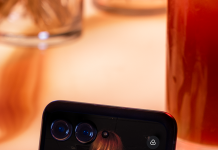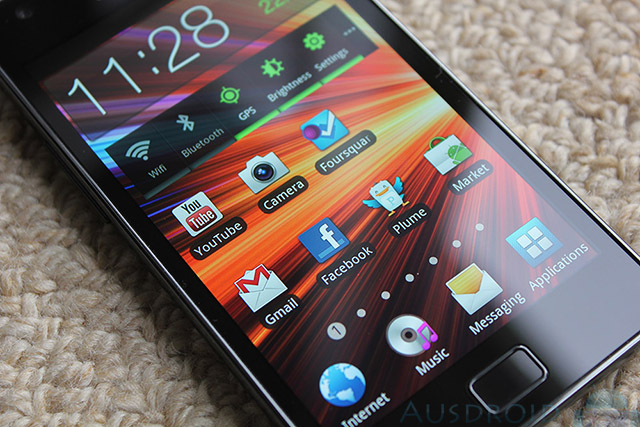
The Samsung Galaxy S II is by far the most hyped device so far this year. I mean who wouldn’t get hyped up over a 4.3″ Super AMOLED + display, 1.2GHz Dual-Core CPU and Quadband 3G supporting every network in Australia at the proper HSPA+ speed of 21Mbit. The Samsung Galaxy S set the benchmark last year and there’s no doubt the Galaxy S II has done the same this year. Just from this intro you can tell how I felt about using the device, though you can read on for some more detail. You know you want to.
Pros..
- Insanely good 4.3″ Super AMOLED + display
- Snappy 1.2GHz dual-core CPU
- Incredibly thin at 8.49mm
- Ability to shoot semi-legible 1080p video
- Quadband HSPA+ (21Mbit/7.56Mbit) – Works on every Australian network
Cons..
- Kies syncing software for your PC
- Fairly average loudspeaker
- TouchWiz, even though it does the job, is too iPhone-ish
- No notification LED!!1! *angry face*
- No native micro-HDMI connection
Hardware..
This is it ladies and gentlemen, the premium hardware you’ve been waiting for is here: 4.3″ Super AMOLED + display, 1.2GHz Dual-Core CPU, Quadband HSPA+ 850/900/1900/2100MHz, 8MP Camera w/ 1080p Video Recording and heaps more. Samsung have pushed the boundaries with the Galaxy S II, in doing so they’ve created the most powerful and good looking device on the market; yes I think it’s better looking than the Xperia Arc that I was complete smitten with and that’s saying something. I can see the Galaxy S II being a stand out device for the next year, just like the original Samsung Galaxy S was. The hardware packed into this bad boy will not let you down or leave you waiting.
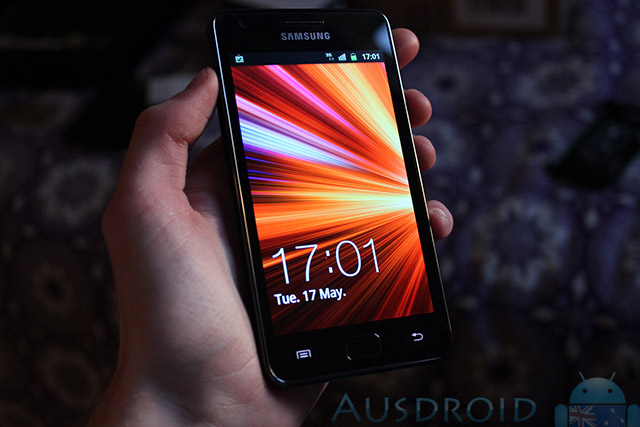
Build..
The Samsung Galaxy S II is very light weighing in at 116 grams thanks to its plastic design. Yep, that’s right plastic. The thin back cover is matte plastic and looks very nice, though it does give you more of a peeling sensation when you’re taking it off to stick in your SIM card and MicroSD card. The on the lower end of the back of the Galaxy S II is a hump where the antenna and loudspeaker are placed. The upper section of the back is where you’ll find the 8MP Camera and LED Flash which can shoot your videos in 1080p, but more on that later.
On the left-hand side is the volume rocker and on the right-hand side is the power/lock button, which is the same place as the Galaxy S and Nexus S. On the bottom is the microphone and micro-USB connector which can output HDMI with an adapter which hasn’t been released yet. Just above the screen is the speaker, 2MP Camera and various sensors. Under the screen are the (L-to-R) capacitive menu button (long press for search), physical home button and capacitive back button. Last but not least is the 3.5mm headphone jack and what appears to be a noise cancelling microphone on the top of the device.
With its thickness measuring in at just 8.49mm, the Galaxy S II is really, really thin, though because it’s quite wide you don’t notice how thin it is when you’re holding it in your hand. You notice it more when you just look at the device. Either way, the thickness of the Galaxy S II is amazing and I love it. As I mentioned before the phone is quite wide, especially in my smaller hands, so I can tell you right now that if you have small hands you might struggle just a little bit with the size of the phone.
What’s missing is the obligatory notification LED, so you don’t always know when you have a text, email or any other notification waiting for you. Sure there are mods you can make to the phone to make the two capacitive buttons flash, but your average user isn’t going to do that at all. Annoying.
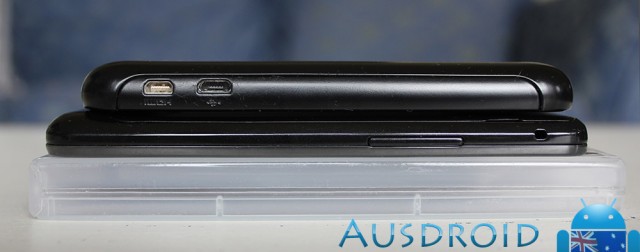
Display..
Gorilla Glass is used on the front of the Galaxy S II which is a great design move by Samsung. It ensures the screen is scratch-resistant but also makes the phone as solid and durable as it seems to be (ie. it doesn’t bend at all). On the Ausdroid Podcast I did test out the Gorilla Glass by taking to it with a screwdriver, was it scratch resistant? Yes — kind of — in certain lighting conditions and depending on the amount of fingerprints on the screen you can only just make out minor markings.
However under that Gorilla Glass is the immaculate 4.3″ Super AMOLED + display. I thought the Bravia powered display on the Xperia Arc produced amazing colours, then here comes the Galaxy S II and kicks it out the park. Blacks are literally black thanks to the pixels switching off when black is on the screen and colours are vibrant and sometimes a little bit unnatural due to the intensity of some colours. Coming from the Motorola Atrix which has a qHD (960×540) display, it’s annoying coming back to 800×480 as everything looks blown up and a little out of proportion, however you’re not going to have this problem if you’ve never used a qHD equipped device beforehand. The Galaxy S II is going to be up against some stiff competition when the HTC Sensation launches with its qHD Super LCD display.
An interesting piece of information for you: the Galaxy S II can respond to 10 simultaneous finger presses. I don’t know when you’d ever have to place 10 fingers on a 4.3″ display, but hey, it’s there if you need it. I can imagine a good game of finger twister working out well.
In short, Galaxy S II has the most amazing screen on the market and is one of its major selling points along with its CPU which we’ll get to next.
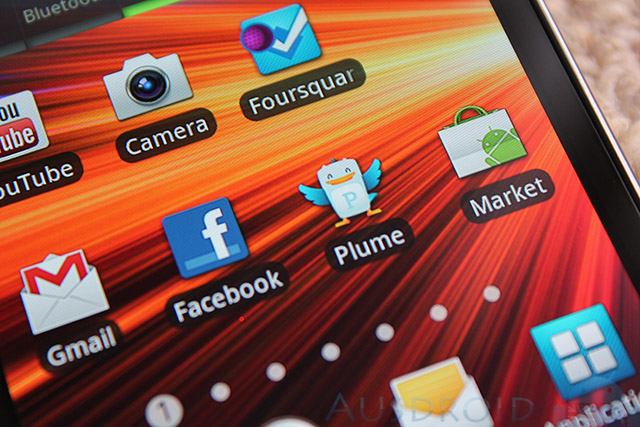
CPU..
We don’t usually have much to say about the processor powering the device we’re reviewing but in this case I think it’s worth a mention. The Galaxy S II will be the third device to launch in Australia with a dual-core processor and it will be the fastest one as well seeing as though it’s clocked at 1.2GHz on each core. It’s also the first dual-core device to not be powered by NVIDIA’s Tegra 2, which is the CPU behind the Motorola Atrix and LG Optimus 2X, instead it uses Samsung’s own Exynos 4210 CPU. The processing power of this CPU really shines when you benchmark it and we’ve got those benchmark specs down a little lower in the review for you to take a look at.
I was also able to playback 1080p video on the device without any lag, so if you have any Full HD movies, you can put them on the Galaxy S II and not have to worry about any lag or distortion of the video.
The Galaxy S II was originally going to launch with its CPU clocked at 1GHz, however pressure from HTC’s upcoming launch of the Sensation, which is clocked at 1.2GHz, Samsung felt the need to bump up its own CPU’s clock speed. It can go even higher than 1.2GHz and we’ll get to that a bit later when I talk about rooting this device.
Camera..
Samsung made a big effort to point out the capabilities of the Galaxy S II’s Camera and it doesn’t disappoint. With 8 megapixels and an LED flash at your disposal, you can take semi decent shots at any time and place. I’m not a professional photographer so I can’t rate how well this camera does in the general scheme of things, but I feel it does a very good job. It can also shoot video all the way up to 1080p. Yep, full HD and it even has continuous auto-focus which is a brilliant feature to have, though if you do bump the phone the video quality does turn to jelly. I found that when you bumped up the resolutions in the camera settings, the further the phone would zoom in during video mode. I’m not sure of the reasoning behind this, so if you do let us know in the comments. Pics and vidoes for your viewing pleasure are below.
[nggallery id=78]

Battery..
The Battery in the Galaxy S II is 1650mAh which isn’t exactly massive but isn’t small either. It’s ~300mAh less than the Atrix and ~400mAh more than the Desire HD just for a random caparison. I was lucky to get 12 hours of semi-draining use out of the device. I was streaming video for iView, listening to music and the obsessive checking of Facebook & Twitter at every chance I got, along with regular syncing of Gmail and everything else going on in the background. So it’s not great, but for a 1.2GHz dual-core that’s pretty good.

Telephony..
One of the many traits the Galaxy S II has to offer is its ability to make phone calls. The in-call volume can be rather soft at times, so I had to make sure the volume was as high as it would go. It’s nothing major, but certainly something worth mentioning.
I also think it’s worth noting the Galaxy S II is quadband, meaning it can function of 3G bands 850/900/1900/2100MHz, or in layman’s terms, it will work flawlessly on every single network in Australia. It’s also the first phone to launch here that has full HSPA+ speeds, that being 21Mbit down and 7.56Mbit up. In reality I managed to maintain 4-8Mbit down and 0.5-3.5Mbit up — not too shabby.
Software..
Ahh yes, Touch Wiz, there’s not a lot I can say about it. It’s speedy and looks nice, but on the other hand it’s a direct copy of the iPhone which has both pros and cons. On the good side people are going to see this and say ‘Wow, that looks like the iPhone but it’s something different so I’ll give it a go’. On the negative side people can look at it and go ‘Wow, they just copied the iPhone so why would I get this’. To Samsung’s credit, at least they haven’t used the glossy icons found on iDevices.
You’re given 7 home screens in which you can flood with app shortcuts and widgets or just leave them empty like I did and admire the good looking background on the Super AMOLED + display. You can flick through each screen individually or you can use the slider under the home screen area to slide to the home screen you wish to view.
There are a number of pre-installed applications such as the photo and video editor that both have extremely basic functionality (the video editor won’t handle 1080p) so I never had the need to use them. There’s Kies which isn’t as bad as what it was on the original Galaxy S, though it did take me 2 hours to get my PC to recognise the phone, so that was fun. There’s an FM radio and a few social networking applications that I replaced with the official apps off the Android Market.
Samsung does have its own app market, however it’s quite crap and there is nothing of value in there. The only good thing for it is to update system applications OTA such as the Camera and Kies which both updated in the time I’ve been reviewing the device.
I know I’m not a fan of Touch Wiz, however my friends that own the Galaxy S don’t mind it. So each to their own in regards to the UI.
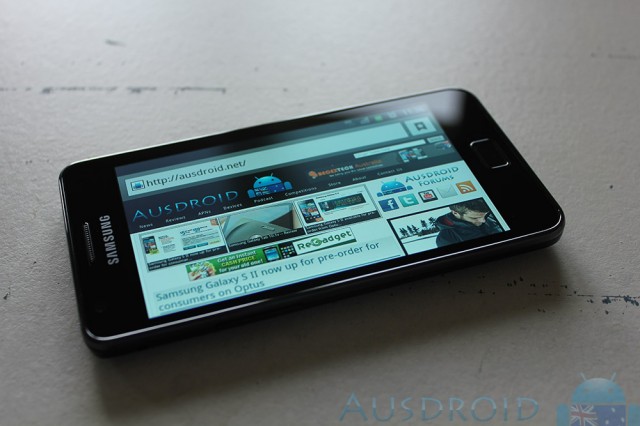
Root..
This section is more suited to the more savvy Android users, so if you don’t know what rooting is in terms of Android modification feel free to completely skip this part of the review.
You can root and install custom builds of Android onto the Galaxy S II, which is a major selling point to the Android developer community. The bootloader is unlocked and it’s fairly easy to install a custom build once your computer recognises the device (it took me 2 hours to get this part right). Once I rooted the Galaxy S II, I then overclocked it to 1.5GHz which is absolutely amazing. I could playback 1080p YouTube videos on the desktop site with absolutely no lag I also scored 3,800 on quadrant. However, the device did heat up to the point where I couldn’t hold it anymore which in turn lead to the battery going flat at more noticable pace. So if you’re a user who’s into this kind of thing, this is certainly the device for you.
Benchmarking..
| Neocore (Frames/sec) | Quadrant (Higher = better) | |
|---|---|---|
| HTC Desire | 28.1 | 1240 |
| Huawei IDEOS X5 | 45 | 1375 |
| Sony Ericsson Xperia Play | 59.8 | 1351 |
| Sony Ericsson Xperia Arc | 58.3 | 1579 |
| Motorola Atrix | 54.1 | 2801 |
| Galaxy S II | 59.8 | 3428 |
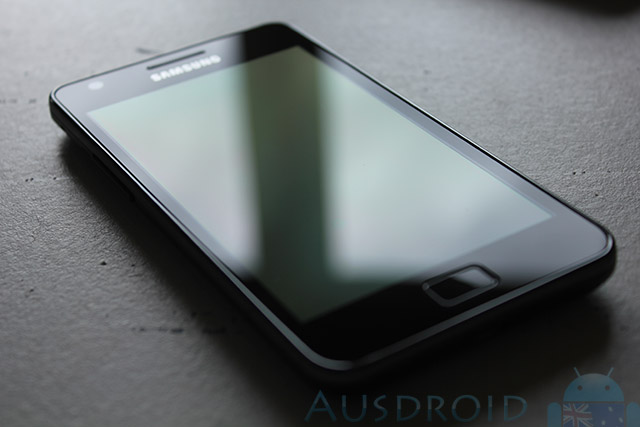
Conclusion..
I’m going to be recommending the Galaxy S II to friends of mine who want an Android device. I mean if you look at its specs, it just boggles the mind. Sure, the price is steep moment, but everything is like that when it first launches and you’ll find that it will drop once stock becomes readily available through online stores such as our friends at MobiCity and carriers like Optus and Telstra who will be stocking the device throughout June.
In fact I loved the Galaxy S II so much that I even purchased it from MobiCity just days after receiving it as a review model, so it has my full support. If power, speed, good looks and little bit of plastic are things you look for in a device, then this is the one and only device for you. Though it will be facing some strong competition from the HTC Sensation when it launches here in July, and yes, I will be doing a comparison of both of these devices in the future. But for now, the Galaxy S II is the only way to go for a dual-core device.
As usual if you have any questions about the device or something you want to know in more details, please leave it in the comments below and don’t complain that I left anything out. I love going through and having a good conversation with you all.



